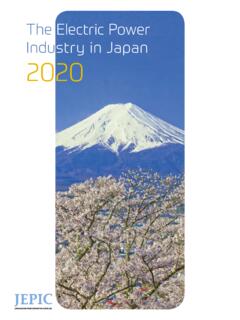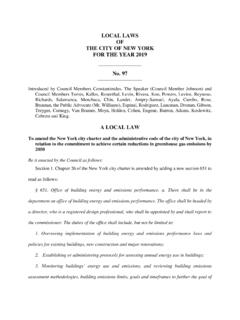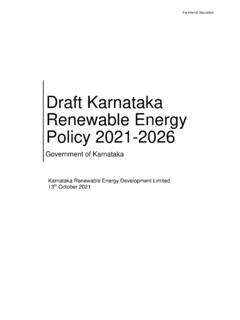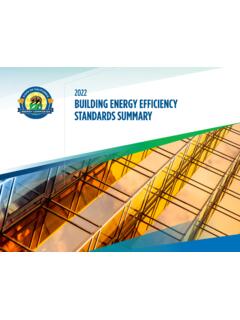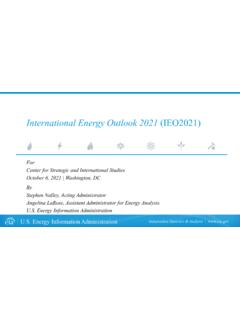Transcription of National Renewable Energy Policy - ZERA
1 Republic of Zimbabwe MINISTRY OF Energy AND POWER DEVELOPMENT National Renewable Energy Policy August 2019 Republic of Zimbabwe MINISTRY OF Energy AND POWER DEVELOPMENT National Renewable Energy Policy August 2019 National Renewable Energy Policy | Table of contents 01 Table of contents 1. Country Overview 13 Demographics 13 Economy 13 Energy Sector 13 Current Acts and Policies 14 Consultations 15 2. Renewable Energy in Zimbabwe 16 Renewable Energy Potential in Zimbabwe 16 3. Barriers to Uptake of Renewable Energy in Zimbabwe 17 4. Policy Vision, Goal and Objectives 19 Vision 19 Policy Principles 19 Goals and Objectives 20 5. Policy Term 20 6. Setting Targets for Renewable Energy 21 Policy Provisions to Enforce RE Targets 22 Objectives 22 Action Points 23 7.
2 Incentives for Promoting Investment in Renewable Energy 24 National Project Status and Tax Incentives to Renewable Energy Projects 24 Prescribed Asset Status to Renewable Energy Projects 24 Viability Gap Funding for Off-grid Community Project in Rural Areas 24 Incentives for Sale of Power to Third Party Grid Access 25 Reduced Licensing Fees and Requirements for Developers of RE Projects 25 Policy Provisions to Provide Incentives for Promoting Investment in RE 25 Objectives 25 Action Points 26 8. Procurement Mechanisms for Renewable Energy in Zimbabwe 26 Sale of Power to the Utility 26 Standard Bankable PPA and RfP 27 Procurement of Energy from Government Utilities 28 National Renewable Energy Policy | Table of contents 02 Policy Provisions for Procurement 28 Objectives 28 Action Points 29 9.
3 Addressing the Development Risks in Renewable Energy Projects 30 Approval Timelines 30 Setting Up a Nodal Agency 31 Pre-Development Phase 32 Development Phase 32 Execution Phase 33 Land Acquisition 33 Policy Recommendations for Land Acquisition for Renewable Energy Projects 33 Policy Provisions to Address Development Risks for Renewable Energy Projects in Zimbabwe 34 Objectives 34 Action Points 34 10. Promoting Off-grid Technologies and Other Clean Energy Solutions in Zimbabwe 36 Guidelines to Promote Off-grid Technology and Other Clean Energy Solutions in Zimbabwe 36 Standards and Specifications 36 Procurement Method 36 Financing the Development of Off-grid Technologies and Other Clean Energy Projects 37 Other Provisions to Promote Development of Off-grid and Clean Energy Projects 37 Guidelines to Implement Programmes for Off-grid and Clean Energy Technologies 38 Off-grid Technologies 39 Clean Energy Solutions 39 Policy Provisions for Promoting Off-grid Technologies and Clean Energy Solutions in Zimbabwe 40 Objectives 40 Action Points 41 11.
4 Promote Local Manufacturing of Renewable Energy Technologies 42 Policy Provisions to Promote Local Manufacturing of Renewable Energy Technologies 42 Objectives 43 Action Points 43 12. Skills Development and Technology Transfer 43 Policy Provisions to Enhance Skills Development in Zimbabwe 44 Objectives 44 Action Points 44 National Renewable Energy Policy | Table of contents 03 13. Biofuels in Zimbabwe 45 14. Funding Mechanisms for Renewable Energy 45 Domestic and Foreign Banks 45 Green Energy Fund 45 International Donor Community Funding and NGO s 46 Sovereign Guarantee 46 Prescribed Asset Status 47 Policy Provisions for Funding in Zimbabwe 47 Objectives 47 Action Points 47 15. Improving Socio-economic Conditions in Zimbabwe 48 Promoting Local Entrepreneurs and Community Development through Renewable Energy Projects 51 Social Impact Assessment of Renewable Energy Projects 51 Policy Provisions for Improving Socio-economic Conditions in the Country 52 Objectives 52 Action Points 52 16.
5 Institutional Framework for Renewable Energy in Zimbabwe 53 Action Plan for implementation of Policy Provisions 54 Annexure 1. Computation of Renewable Energy Targets 54 National Renewable Energy Policy | Ministerial Foreword 04 Ministerial Foreword Energy has a major role to play in the overall economic and social development of Zimbabwe. The Energy sector in Zimbabwe is overseen by the Ministry of Energy and Power Development (MoEPD). The National Energy Policy (NEP) was promulgated in the year 2012 to provide an overal framework for optimal supply and utilization of Energy in general and ensure access to modern Energy services for the country s socio-economic development. The National Renewable Energy Policy (NREP) focusses on the Energy needs of the country from Renewable Energy resources.
6 It is an initiative aimed at securing the long term Energy needs of the country in a sustainable way. The Policy aims to augment the National vision of the country as spelt out by the President of Zimbabwe, His Excellency Cde. E. D. Mnangagwa. The thrust of Vision 2030 is t o transform Zimbabwe into an upper middle income economy. This vision also aims to raise employment levels upwards, and to progressively reduce the poverty rate to levels consistent with the upper middle income economies, among other factors. These will be achieved through Five pillars of Vision 2030 which are as follows: , economic growth, Stability and Financial re-engagement, Development, and Enablers. MOEPD is under the Cross-Cutting Enablers Pillar and this Policy is one of the initiatives undertaken by my Ministry to achieve this vision.
7 The pursuit of Vision 2030 would be anchored on the following National priorities: Private sector-led rapid growth and development, Enhanced domestic and foreign investment as encapsulated by the mantra Zimbabwe is open for business , Creation of a responsive, efficient and e-enabled Public Service apparatus. All of these are clearly defined in this Policy . Zimbabwe at present is mainly dependent on coal, petroleum, hydroelectric power and fuel-wood to meet its Energy needs. The country is dependent on petroleum and power imports due to lack of petroleum resources and ageing electricity system infrastructure. The shortage of electricity is compounded by the fact that little investment has occurred in the sector in the past Twenty-five (25) years prior to the year 2014. Due to the frequent power shortages, business had resorted to purchasing and operating diesel generators as an alternative to grid power.
8 Diesel generators are expensive to operate and pollute the environment. More than sixty percent (60%) of the population still rely on solid biomass fuel for thermal needs and have no access to clean Energy sources. Renewable Energy sources will help address these problems. Also, Zimbabwe has huge and diversified Renewable Energy potential which needs to be harnessed effectively to create a sustainable Energy portfolio in the country. The National Renewable Energy Policy also addresses the Climate Change concerns and the country s commitment to the World to reduce greenhouse gas (GHG) emissions. Zimbabwe has vast Renewable Energy resources like solar, hydro, biomass and to a limited extent, wind and geothermal, that to date have largely remained unexploited.
9 The majority of the population especially in rural areas, has no access to basic Energy services with the Energy supply-demand gap continuing to widen. The Government of Zimbabwe, non-governmental organizations (NGOs) and the private sector have supported the development of Renewable Energy since the country`s Independence in the year 1980. A number of programmes have been implemented to promote the adoption of Renewable Energy technologies such as National Energy Policy , Sustainable Energy for All (SE4 ALL), The National Biogas Programme, Rural Electrification (using solar mini-grids), Nationally Determined Contributions (NDCs), Renewables Readiness Assessment (RRA), Climate Policy among others. Over the years, Renewable Energy has become competitive and is achieving grid parity globally.
10 Therefore, it is an opportune National Renewable Energy Policy | Ministerial Foreword 05 time to exploit the huge Renewable Energy potential to meet Zimbabwe s growing Energy demand, achieve universal Energy access and secure the country s long term Energy needs in a sustainable manner. This National Renewable Energy Policy was developed by the MoEPD to promote and drive investment into the sector by overcoming a number of barriers that currently exist in the Energy sector. It also aims to improve the livelihood of the rural population by providing access to reliable Energy through off-grid solutions, and thus creating opportunities which did not exist before. Fortune Chasi (MP). MINISTER OF Energy AND POWER DEVELOPMENT. National Renewable Energy Policy | Acknowledgement 06 Acknowledgement The formulation of the National Renewable Energy Policy involved a robust stakeholder consultation process around different thematic areas of the Policy , such as Renewable Energy targets, procurement models, project development processes, financing, skills development, and environmental and social impacts.
